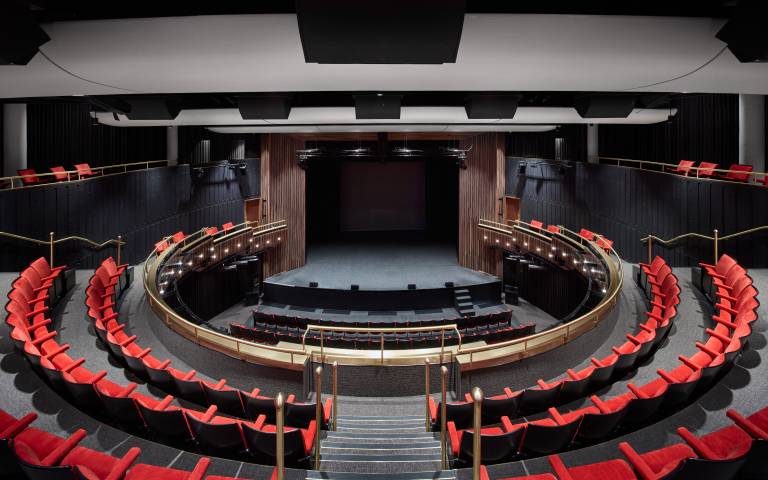Bloomsbury Theatre reopens following major renovation
13 February 2019
The historic Bloomsbury Theatre at UCL has officially reopened its doors following a specialist £19.8m restoration project.

As part of a cutting-edge revamp, the 1960s Brutalist landmark building – famous for its innovative comedy, theatre, music and dance – has been expertly renovated and its 541-seat auditorium, stage and fly-tower has been upgraded.
The modern makeover gives student societies and productions the full benefits of a 21st century theatre and creates the opportunity for collaboration between academics, artists, performers, directors and companies.
When formally reopening the theatre, UCL President & Provost, Professor Michael Arthur, said: “This is the perfect opportunity to celebrate the important and eclectic history of the Bloomsbury Theatre while looking ahead at what will be an exciting and dynamic programme of events.
“The theatre is a unique and special asset at the heart of our Bloomsbury campus. Along with the soon to be opened new Student Centre, it will offer our community and our neighbours access to exciting new art, culture and architecture on their doorstep.”
The three and half year renovation is the first major investment in the building’s history, aimed at reimaging the theatre’s technical and audio-visual features, while maintaining the aesthetic and historic fabric of the theatre.
UCL Culture, who manage the theatre and its programming, have developed a refreshed and more dynamic programme of events. While continuing to offer high profile and household names, they will bring in more research-led performance, that offer opportunities for ground-breaking discoveries across art, design, science and technology.
They will also dedicate more space for student-led productions, providing greater opportunity for students to learn, experiment and create outside of their academic programmes.
“We are excited to present a refreshed approach to our programming that offers a mix of new and experimental theatre, research-driven content and high-profile and household names,” said Simon Cane, Executive Director, UCL Culture.
“This will allow us to be at the forefront of the use of theatre and performance as a mode of research and investigation, challenging traditional ideas about the role of theatre in a research intensive university.”
First opened in 1968 as the Central Collegiate Building Auditorium (later the Collegiate Theatre), it was renamed in 1982 as The Bloomsbury Theatre to reflect its geographical location, as well as the artistic associations of the name. A studio with 70 seats was added in 2015 providing a more flexible space and an alternative to the main theatre.
Over the years it has attracted huge artists including UCL alumnus Ricky Gervais, singer Adele, American Jazz artist Gregory Porter, comedian Jo Brand and world famous Stomp percussion group.
It is part of the Transforming UCL programme, the largest capital programme in the university’s history which involves the investment of £1.2 billion to upgrade and expand UCL’s accommodation and facilities.
The project, which was designed by Nicholas Hare Architects, is on track to achieve a RICS SKA Gold, the highest possible sustainable fit-out rating.
Frank Penter, Director of Operations, UCL Culture, added: “The significant technical and infrastructure improvements will allow us to support shows at the cutting edge of theatre.
“Some of the upgrades are important access and behind the scenes improvements, that may not be immediately obvious to the visitor. But what we hope it does is improve the experience for visitors and performers alike.”
Highlights from the renovation include:
Sustainability features:
- A wide range of technologies to improve energy efficiency, including new lighting and controls; and a ventilation system with heat recovery
- The theatre roof hosts solar panels which supply the neighbouring Student Centre, providing ‘free’ low carbon energy
- Construction materials with low environmental impact have been prioritised
Enhanced technical and audio-visual features
- A comprehensive new stage lighting and audio-visual set-up along with enhanced acoustics.
- A new safety curtain has been installed whilst the stage has been replaced with semi-sprung flooring designed to reduce bounce and enhance performance
Restoration of historical features
- Reinstatement of the historic paint-frame, a huge canvas on which artists create the scenery or backdrop of a performance
- Upgrades of the adjacent workshop, used for full-scale set production Replacement of the proscenium stage’s motorized thrusts, which can be moved to expose an orchestra pit accommodating up to 60 musicians or increase the stage size
Design and decorative highlights
- Complete replacement of the internal finishes including decorative linings, joinery and metalwork
- Black painted tulipwood is used to create the new acoustic panelling to the auditorium while American black walnut characterises the balcony fronts and proscenium as well as the new auditorium doors, which feature a diamond veneer pattern
- In its new auditorium timber is contrasted with satin-matt finished brass ironmongery and metalwork, which combined with the plush red seating, create a sense of understated sumptuousness, perfectly complementing the original brutalist design
Improved accessibility and backstage enhancements
- Improved access for disabled visitors and a wheelchair accessible dressing room at stage level
- Beyond the auditorium the building now boasts a renovated technical office and wardrobe area with refreshed dressing rooms and more practical backstage routes for technicians
Links
Image
- Credit: icholas Hare Architects LLP and alanwilliamsphotography.com
Media contact
Natasha Downes
tel: +44 20 3108 3844
E: n.downes [at] ucl.ac.uk
 Close
Close

